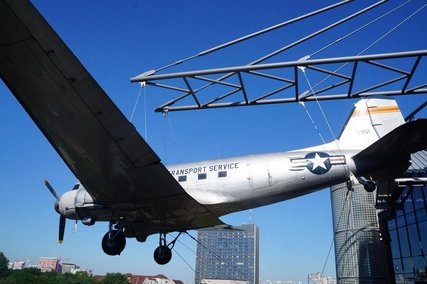
Sometimes it's the little things that give us courage and hope - even if it's just a piece of chocolate. You can guess which powerful story we have chosen for you this time? That's right, this time we're introducing you to Gail Halvorsen, who was the first pilot to drop small parachuted parcels of sweets over the mounds of rubble on the Neukölln side of Tempelhofer Feld for the children waiting there, thus unintentionally initiating an ingenious PR campaign for the Western occupying forces.
An ordinary post-war day in 1948: pilot Gail Halvorsen is taking film footage of the destroyed Berlin, right at the runway of Tempelhof Airport. Suddenly children run up to him. He wants to do something good for them and gives them two strips of chewing gum that he still finds in his trouser pockets.
This is hardly enough for the many children, not everyone gets one of the tiny pieces into which he has divided the chewing gum strips, some can only smell the wrapping paper. Halvorsen promises the children, "Tomorrow I'll drop chocolate and chewing gum from my plane."
US-pilots let 20 tonnes of chocolate fall from the sky

He collects all the chocolate bars and sweets from his colleagues and the next day throws them out of the emergency drop chute behind his pilot seat, tied to little handkerchief parachutes. Word of the "Rosinenbomber" spreads among the children of Berlin and week after week more children come to the fence. They wait for "Uncle Wigglewing". That's Halvorsen's name later on, because he waggles the wings of the plane back and forth when he's landing, so that the children can recognise his plane.
After a few weeks, a newspaper article about the chocolate parachutes appears and the children of the town write many, many letters to "Uncle Wigglewing". More and more pilots follow Halvorsen's example and drop chocolate and chewing gum. Schoolchildren in America donate kilos of sweets and homemade parachutes. In the 14 months of the blockade, 20 tonnes of sweets sail out of the Berlin sky.
Airlift unintentionally becomes a brilliant PR campaign

The Soviets wanted to test the loyalty of the Western occupation forces with the blockade and expected failure. After about 450 days, they achieved the opposite and unintentionally provoked an ingenious PR action for the Western occupiers with the airlift. The victors over the Germans become friends.
By September 1949, a total of almost 300,000 "Rosinenbomber" were bringing relief supplies to the enclosed city. They land in Tempelhof, on the airfields in Tegel and Gatow and even with seaplanes on the Wannsee. In memory of them, the Airlift Memorial created by Eduard Ludwig has stood on the Platz der Luftbrücke in front of Tempelhof Airport since 1951. Three struts pointing out of the arch face west and symbolise the air corridors used between the so-called Trizone and West Berlin. The Berliners congenially combine the sense and form of the monument by calling it Hungerharke.
ABOUT BERLIN App
You can also find more powerful stories from Berlin in our ABOUT BERLIN app. You can download it for free for iPhone and Android.


There is a lot to tell. ABOUT BERLIN.





